This topic describes the impact of the Always confidential database feature on system performance in different scenarios to help you evaluate and select an encryption solution.
Test environment
Configuration item | ECS instance on which the test client is deployed | RDS instance | Description |
Region and zone | Shanghai Zone L | Shanghai Zone L | The test is performed in the same region and zone. |
Network type | Virtual private cloud (VPC) | VPC | The test is performed in the same VPC. |
Number of CPU cores and memory capacity | 64 cores, 128 GB | 32 cores, 64 GB | N/A |
Instance family | Compute-optimized Type c7 | Security-enhanced instance family | The RDS instance must belong to the security-enhanced instance family. |
Instance type | ecs.c7.16xlarge | pg.x2t.4xlarge.2c | N/A |
Storage type | Enhanced SSD (ESSD) | PL1 ESSD | N/A |
Instance or image version | Alibaba Cloud Linux 3.2104 64-bit |
| N/A |
Test tool (sysbench)
sysbench is a modular, cross-platform, and multi-threaded benchmark tool that can be used to evaluate the performance of a heavily loaded database system based on core metrics. For more information about sysbench and how to use sysbench, see sysbench documentation.
Performance metrics
Transactions per second (TPS): the number of transactions that are successfully committed on an RDS instance per second.
Average latency: the average period of time that is required for an RDS instance to execute a transaction. Unit: milliseconds.
Test schema
By default, sysbench uses the following table schema:
CREATE TABLE test1(
id INTEGER NOT NULL,
k INTEGER DEFAULT '0' NOT NULL,
c CHAR(120) DEFAULT '' NOT NULL,
pad CHAR(60) DEFAULT '' NOT NULL,
PRIMARY KEY (id)
);
CREATE INDEX k_1 on test1(k);Test procedure
In this test, table columns are encrypted to analyze the impacts of the Always confidential database feature on the performance of an RDS instance in different scenarios.
Install the PostgreSQL client on the ECS instance. For more information, see Official documentation.
Open the PostgreSQL command-line tool (CLI) and run the following command to connect to the RDS instance:
psql -h <Endpoint of the RDS instance> -U <Username> -p <Port number> -d postgresNoteFor more information about how to obtain the endpoint and port number of an RDS instance, see View and change the internal and public endpoints and port numbers of an ApsaraDB RDS for PostgreSQL instance.
For more information about how to obtain the username, see Create an account.
You can also use Data Management (DMS) to connect to an RDS instance in the ApsaraDB RDS console. For more information, see Use DMS to log on to an ApsaraDB RDS for PostgreSQL instance.
Create a test database.
CREATE DATABASE testdb; \c testdbCreate an encrypted table and encrypt columns based on different scenarios.
Scenario
Description
Example SQL statement
The primary key column is not encrypted. Other columns are encrypted.
In most scenarios,
idis an auto-increment field and irrelevant to business. In this test scenario, theidcolumn is not encrypted. Other columns are encrypted as sensitive information.CREATE TABLE test1( id INTEGER NOT NULL, k enc_int4 DEFAULT '\xa509008855508aade16ec573d21e6aca47ab5e490d7044e748161a6635a5d939c5bbbee4' NOT NULL, c enc_text DEFAULT '\x9d39006e340b9cffb37a989ca544e69e6e9c0bdb0b6500a91dcc433dc5df0496' NOT NULL, pad enc_text DEFAULT '\x9d39006e340b9cffb37a989ca544e69e6e9c0bdb0b6500a91dcc433dc5df0496' NOT NULL, PRIMARY KEY (id) ); CREATE INDEX k_1 on test1(k);All columns are encrypted.
In this test scenario, the primary key column is also encrypted.
CREATE TABLE test1( id enc_int4 NOT NULL, k enc_int4 DEFAULT '\xa509008855508aade16ec573d21e6aca47ab5e490d7044e748161a6635a5d939c5bbbee4' NOT NULL, c enc_text DEFAULT '\x9d39006e340b9cffb37a989ca544e69e6e9c0bdb0b6500a91dcc433dc5df0496' NOT NULL, pad enc_text DEFAULT '\x9d39006e340b9cffb37a989ca544e69e6e9c0bdb0b6500a91dcc433dc5df0496' NOT NULL, PRIMARY KEY (id) ); CREATE INDEX k_1 on test1(k);Exit the RDS instance and use sysbench to load the test data.
NoteThis test uses sysbench to load 32 tables. Each table contains one million rows of records.
sysbench --db-driver=pgsql \ --pgsql-host=[database server host] \ --pgsql-port=[database server port] \ --pgsql-user=[database user name] \ --pgsql-password=[database user password] \ --pgsql-db=testdb \ --auto_inc=false \ --table_size=1000000 \ --tables=32 \ --threads=32 \ --time=600 \ --pg_use_encrypt=[true or false] \ oltp_common prepareRun the custom test script.
sysbench --db-driver=pgsql \ --pgsql-host=[database server host] \ --pgsql-port=[database server port] \ --pgsql-user=[database user name] \ --pgsql-password=[database user password] \ --pgsql-db=testdb \ --table_size=1000000 \ --tables=32 \ --threads=XXX \ --time=600 \ --report-interval=1 \ --pg_use_encrypt=[true or false] \ [lua script name] runsysbench --db-driver=pgsql \ --pgsql-host=[database server host] \ --pgsql-port=[database server port] \ --pgsql-user=[database user name] \ --pgsql-password=[database user password] \ --pgsql-db=testdb \ --tables=32 \ oltp_common cleanup
Test scenario 1: The primary key column is not encrypted. Other columns are encrypted.
Each result of this test is the average of the TPS and processing latency of 10 tests, each of which is run for 10 minutes.
The test result also indicates the performance loss caused by decryption of the returned fields on the client.
In the test result, the column chart indicates the TPS, and the line chart indicates the average processing latency of transactions.
Test data
Performance of point queries
Percentage
SQL template
100%
NoteThe percentage indicates the proportion of SQL statements that are defined in the SQL template and executed in a transaction to the total number of SQL statements that are executed in the transaction.
SELECT c FROM test1 WHERE id=?;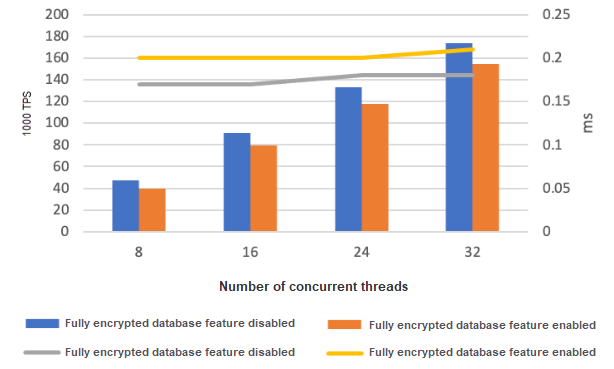
Table 1 1,000 TPS comparison
Number of concurrent threads
Always confidential database feature disabled
Always confidential database feature enabled
Performance loss
8
46.99
39.94
15.0%
16
91.07
79.86
12.3%
24
132.78
117.64
11.4%
32
173.58
154.28
11.1%
Performance of range queries
Percentage
SQL template
100%
SELECT SUM(k) FROM test1 WHERE id BETWEEN ? AND ?;NoteBy default, the length of a range query is 100.
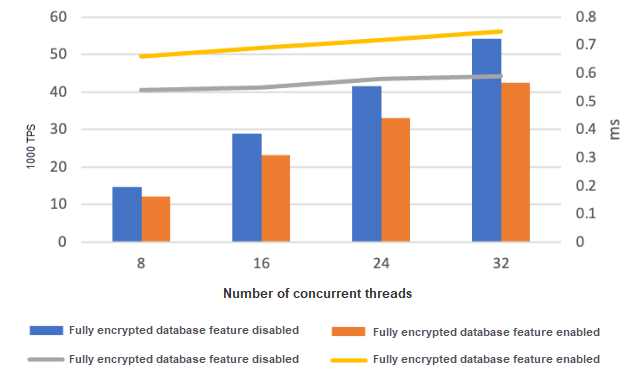
Table 2 1,000 TPS comparison
Number of concurrent threads
Always confidential database feature disabled
Always confidential database feature enabled
Performance loss
8
14.81
12.09
18.3%
16
28.88
23.22
19.6%
24
41.62
33.12
20.4%
32
54.27
42.48
21.7%
Write performance
Percentage
SQL template
25%
UPDATE test1 SET k=k+1 WHERE id=?;25%
UPDATE test1 SET c=? WHERE id=?;25%
DELETE FROM test1 WHERE id=?;25%
INSERT INTO test1 (id, k, c, pad) VALUES (?, ?, ?, ?);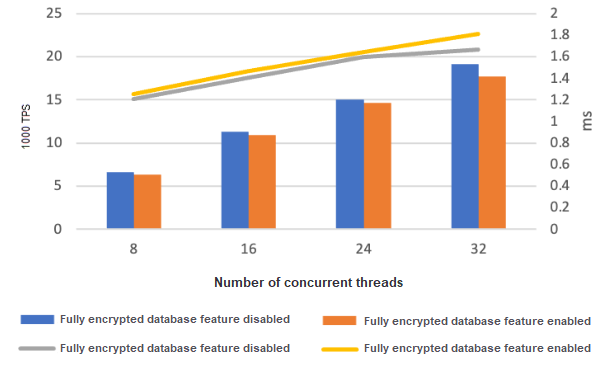
Table 3 1,000 TPS comparison
Number of concurrent threads
Always confidential database feature disabled
Always confidential database feature enabled
Performance loss
8
6.62
6.37
3.8%
16
11.36
10.91
4.0%
24
15.05
14.68
2.6%
32
19.13
17.74
7.3%
Test conclusion
In this test scenario, if you enable the Always confidential database feature, the performance loss is low.
Test scenario 2: All columns are encrypted.
Each result of this test is the average of the TPS and processing latency of 10 tests, each of which is run for 10 minutes.
The test result also indicates the performance loss caused by decryption of the returned fields on the client.
In the test result, the column chart indicates the TPS, and the line chart indicates the average processing latency of transactions.
Test data
Performance of point queries
Percentage
SQL template
100%
SELECT c FROM test1 WHERE id=?;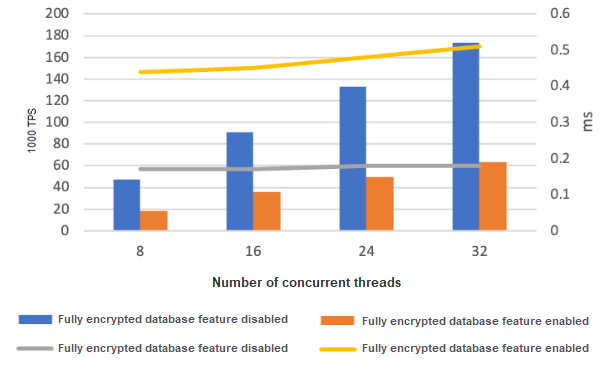
Table 4 1,000 TPS comparison
Number of concurrent threads
Always confidential database feature disabled
Always confidential database feature enabled
Performance loss
8
46.99
18.31
61.0%
16
91.07
35.66
60.8%
24
132.78
49.85
62.5%
32
173.58
63.34
63.5%
Performance of range queries
Percentage
SQL template
100%
SELECT SUM(k) FROM test1 WHERE id BETWEEN ? AND ?;NoteBy default, the length of a range query is 100.

Table 5 1,000 TPS comparison
Number of concurrent threads
Always confidential database feature disabled
Always confidential database feature enabled
Performance loss
8
14.81
2.83
80.9%
16
28.88
5.52
80.9%
24
41.62
7.12
82.9%
32
54.27
8.71
84.0%
Write performance
Percentage
SQL template
25%
UPDATE test1 SET k=k+1 WHERE id=?;25%
UPDATE test1 SET c=? WHERE id=?;25%
DELETE FROM test1 WHERE id=?;25%
INSERT INTO test1 (id, k, c, pad) VALUES (?, ?, ?, ?);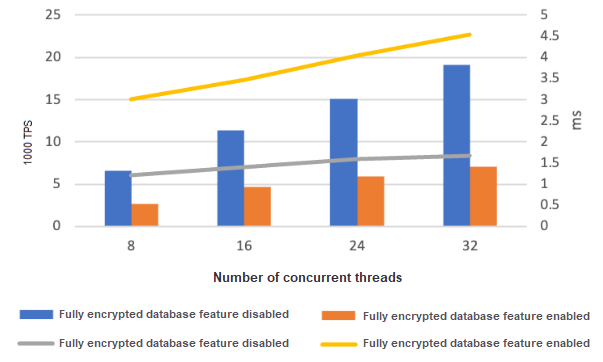
Table 6 1,000 TPS comparison
Number of concurrent threads
Always confidential database feature disabled
Always confidential database feature enabled
Performance loss
8
6.62
2.67
59.7%
16
11.36
4.62
59.3%
24
15.05
5.92
60.7%
32
19.13
7.04
63.2%
Test conclusion
In this test scenario, you must decrypt columns on the client. In addition, Intel SGX-related commands are more frequently run to query the indexes of encrypted columns. As a result, the total cost and performance loss are higher than those in Test scenario 1.
Test scenario 3: Non-primary key columns are queried.
Each result of this test is the average of the TPS and processing latency of 10 tests, each of which is run for 10 minutes.
The test result also indicates the performance loss caused by decryption of the returned fields on the client.
In the test result, the column chart indicates the TPS, and the line chart indicates the average processing latency of transactions.
In this test scenario, the encdb_btree extension provided by Alibaba Cloud is used to improve the efficiency of ciphertext index-related operations in Always confidential databases. For more information, see Use the encdb_btree extension.
Test data
Point query
Percentage
SQL template
100%
SELECT c FROM test1 WHERE k=?;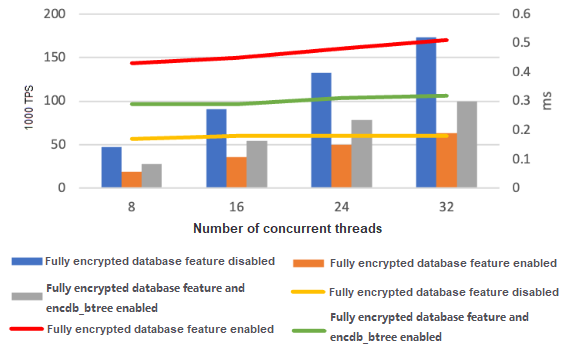
Table 7 1,000 TPS comparison
Number of concurrent threads
Always confidential database feature disabled
Always confidential database feature enabled
Always confidential database feature enabled and the encdb_btree extension used
8
47.27
18.49
27.86
16
90.41
35.85
54.4
24
132.66
49.97
78.21
32
172.96
63.32
99.38
Range query
Percentage
SQL template
100%
SELECT SUM(k) FROM test1 WHERE k BETWEEN ? AND ?NoteBy default, the length of a range query is 100.
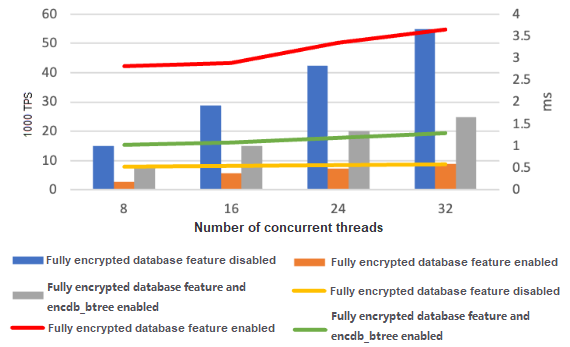
Table 8 1,000 TPS comparison
Number of concurrent threads
Always confidential database feature disabled
Always confidential database feature enabled
Always confidential database feature enabled and the encdb_btree extension used
8
14.97
2.83
7.8
16
28.89
5.53
15.2
24
42.38
7.15
20.09
32
54.8
8.75
24.86
Test conclusion
In this test scenario, the query performance on non-primary key columns is similar to the query performance on primary key columns. After the Always confidential database feature is enabled, you can use the encdb_btree extension to improve the query performance of ciphertext data.
Usage suggestions
We recommend that you enable the Always confidential database feature to encrypt only sensitive data columns.